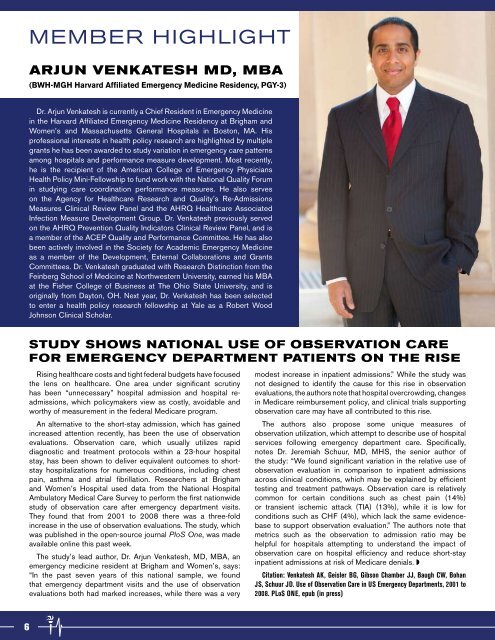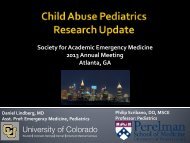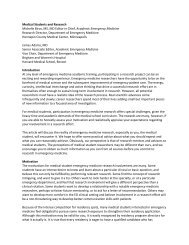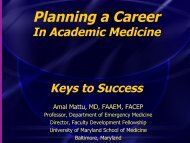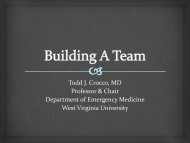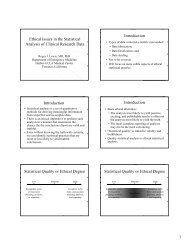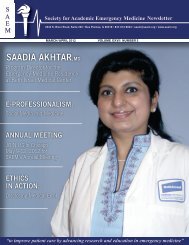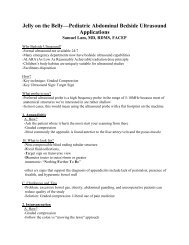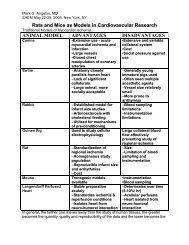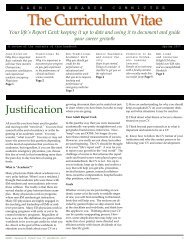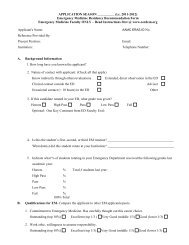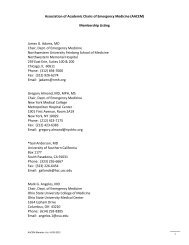Nov-Dec 2011 Newsletter.pdf - The Society for Academic ...
Nov-Dec 2011 Newsletter.pdf - The Society for Academic ...
Nov-Dec 2011 Newsletter.pdf - The Society for Academic ...
Create successful ePaper yourself
Turn your PDF publications into a flip-book with our unique Google optimized e-Paper software.
member highlight<br />
Arjun Venkatesh MD, MBA<br />
(BWH-MGH Harvard Affiliated Emergency Medicine Residency, PGY-3)<br />
Dr. Arjun Venkatesh is currently a Chief Resident in Emergency Medicine<br />
in the Harvard Affiliated Emergency Medicine Residency at Brigham and<br />
Women’s and Massachusetts General Hospitals in Boston, MA. His<br />
professional interests in health policy research are highlighted by multiple<br />
grants he has been awarded to study variation in emergency care patterns<br />
among hospitals and per<strong>for</strong>mance measure development. Most recently,<br />
he is the recipient of the American College of Emergency Physicians<br />
Health Policy Mini-Fellowship to fund work with the National Quality Forum<br />
in studying care coordination per<strong>for</strong>mance measures. He also serves<br />
on the Agency <strong>for</strong> Healthcare Research and Quality’s Re-Admissions<br />
Measures Clinical Review Panel and the AHRQ Healthcare Associated<br />
Infection Measure Development Group. Dr. Venkatesh previously served<br />
on the AHRQ Prevention Quality Indicators Clinical Review Panel, and is<br />
a member of the ACEP Quality and Per<strong>for</strong>mance Committee. He has also<br />
been actively involved in the <strong>Society</strong> <strong>for</strong> <strong>Academic</strong> Emergency Medicine<br />
as a member of the Development, External Collaborations and Grants<br />
Committees. Dr. Venkatesh graduated with Research Distinction from the<br />
Feinberg School of Medicine at Northwestern University, earned his MBA<br />
at the Fisher College of Business at <strong>The</strong> Ohio State University, and is<br />
originally from Dayton, OH. Next year, Dr. Venkatesh has been selected<br />
to enter a health policy research fellowship at Yale as a Robert Wood<br />
Johnson Clinical Scholar.<br />
Study shows national use of observation care<br />
<strong>for</strong> emergency department patients on the rise<br />
Rising healthcare costs and tight federal budgets have focused<br />
the lens on healthcare. One area under significant scrutiny<br />
has been “unnecessary” hospital admission and hospital readmissions,<br />
which policymakers view as costly, avoidable and<br />
worthy of measurement in the federal Medicare program.<br />
An alternative to the short-stay admission, which has gained<br />
increased attention recently, has been the use of observation<br />
evaluations. Observation care, which usually utilizes rapid<br />
diagnostic and treatment protocols within a 23-hour hospital<br />
stay, has been shown to deliver equivalent outcomes to shortstay<br />
hospitalizations <strong>for</strong> numerous conditions, including chest<br />
pain, asthma and atrial fibrillation. Researchers at Brigham<br />
and Women’s Hospital used data from the National Hospital<br />
Ambulatory Medical Care Survey to per<strong>for</strong>m the first nationwide<br />
study of observation care after emergency department visits.<br />
<strong>The</strong>y found that from 2001 to 2008 there was a three-fold<br />
increase in the use of observation evaluations. <strong>The</strong> study, which<br />
was published in the open-source journal PloS One, was made<br />
available online this past week.<br />
<strong>The</strong> study’s lead author, Dr. Arjun Venkatesh, MD, MBA, an<br />
emergency medicine resident at Brigham and Women’s, says:<br />
“In the past seven years of this national sample, we found<br />
that emergency department visits and the use of observation<br />
evaluations both had marked increases, while there was a very<br />
modest increase in inpatient admissions.” While the study was<br />
not designed to identify the cause <strong>for</strong> this rise in observation<br />
evaluations, the authors note that hospital overcrowding, changes<br />
in Medicare reimbursement policy, and clinical trials supporting<br />
observation care may have all contributed to this rise.<br />
<strong>The</strong> authors also propose some unique measures of<br />
observation utilization, which attempt to describe use of hospital<br />
services following emergency department care. Specifically,<br />
notes Dr. Jeremiah Schuur, MD, MHS, the senior author of<br />
the study: “We found significant variation in the relative use of<br />
observation evaluation in comparison to inpatient admissions<br />
across clinical conditions, which may be explained by efficient<br />
testing and treatment pathways. Observation care is relatively<br />
common <strong>for</strong> certain conditions such as chest pain (14%)<br />
or transient ischemic attack (TIA) (13%), while it is low <strong>for</strong><br />
conditions such as CHF (4%), which lack the same evidencebase<br />
to support observation evaluation.” <strong>The</strong> authors note that<br />
metrics such as the observation to admission ratio may be<br />
helpful <strong>for</strong> hospitals attempting to understand the impact of<br />
observation care on hospital efficiency and reduce short-stay<br />
inpatient admissions at risk of Medicare denials. ◗<br />
Citation: Venkatesh AK, Geisler BG, Gibson Chamber JJ, Baugh CW, Bohan<br />
JS, Schuur JD. Use of Observation Care in US Emergency Departments, 2001 to<br />
2008. PLoS ONE, epub (in press)<br />
6


